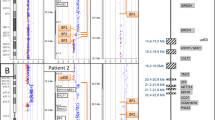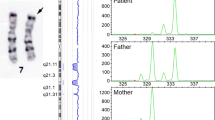Abstract
Zic family member 1 (ZIC1), a gene located on chromosome 3q24, encodes a transcription factor with zinc finger domains that is essential for the normal development of the cerebellum. Heterozygous loss-of-function of ZIC1 causes Dandy-Walker malformation, while heterozygous gain-of-function leads to a multiple congenital anomaly syndrome characterized by craniosynostosis, brain abnormalities, facial features, and learning disability. In this study, we present the results of genetic analysis of a male patient with clinically suspected Gomez-Lopez-Hernandez syndrome. The patient displayed multiple congenital abnormalities, including bicoronal craniosynostosis, characteristic facial features, cerebellar malformation with rhombencephalosynapsis, and temporal alopecia, and a de novo inversion of chromosome 3q. Breakpoint analysis using a Nanopore long-read sequencer revealed a breakpoint in the distal centromere of 3q24 located 7 kb downstream of the 3′ untranslated region of ZIC1. On the basis of the clinical similarities, we concluded that the abnormalities in this patient were caused by the transcriptional dysregulation of ZIC1. We hypothesize the underlying molecular mechanisms of transcriptional dysregulation of ZIC1 such as the abnormalities in topologically associated domains encompassing ZIC1. This study highlights the usefulness of long-read sequencing in the analysis of de novo balanced chromosomal abnormalities.
This is a preview of subscription content, access via your institution
Access options
Subscribe to this journal
Receive 12 print issues and online access
$259.00 per year
only $21.58 per issue
Buy this article
- Purchase on Springer Link
- Instant access to full article PDF
Prices may be subject to local taxes which are calculated during checkout




Similar content being viewed by others
References
Aruga J, Yokota N, Hashimoto M, Furuichi T, Fukuda M, Mikoshiba K. A novel zinc finger protein, Zic, is involved in neurogenesis, especially in the cell lineage of cerebellar granule cells. J Neurochem. 1994;63:1880–90.
Grinberg I, Northrup H, Ardinger H, Prasad C, Dobyns WB, Millen KJ. Heterozygous deletion of the linked genes ZIC1 and ZIC4 is involved in Dandy-Walker malformation. Nat Genet. 2004;36:1053–5.
Twigg SRF, Forecki J, Goos JAC, Richardson ICA, Hoogeboom AJM, van den Ouweland AMW, et al. Gain-of-function mutations in ZIC1 are associated with coronal craniosynostosis and learning disability. Am J Hum Genet. 2015;97:378–88.
Pangalos C, Hagnefelt B, Lilakos K, Konialis C. First applications of a targeted exome sequencing approach in fetuses with ultrasound abnormalities reveals an important fraction of cases with associated gene defects. PeerJ. 2016;26:e1955.
Miller KA, Twigg SRF, McGowan SJ, Phipps JM, Fenwick AL, Johnson D, et al. Diagnostic value of exome and whole genome sequencing in craniosynostosis. J Med Genet. 2017;54:260–8.
Vandervore LV, Schot R, Hoogeboom AJM, Lincke C, de Coo IF, Lequin MH, et al. Mutated zinc finger protein of the cerebellum 1 leads to microcephaly, cortical malformation, callosal agenesis, cerebellar dysplasia, tethered cord and scoliosis. Eur J Med Genet. 2018;61:783–9.
Sasaki E, Byrne AT, Murray DJ, Reardon W. Caput membranaceum: a novel clinical presentation of ZIC1 related skull malformation and craniosynostosis. Am J Med Genet Part A. 2020;182:2994–8.
Sukhudyan B, Jaladyan V, Melikyan G, Schlump JU, Boltshauser E, Poretti A. Gómez-López-Hernández syndrome: reappraisal of the diagnostic criteria. Eur J Pediatr. 2010;169:1523–8.
Rush ET, Adam MP, Clark RD, Curry C, Hartmann JE, Dobyns WB, et al. Four new patients with Gomez-Lopez-Hernandez syndrome and proposed diagnostic criteria. Am J Med Genet Part A. 2013;161:320–6.
Kobayashi Y, Kawashima H, Magara S, Akasaka N, Tohyama J. Gómez-López-Hernández syndrome in a Japanese patient: a case report. Brain Dev. 2015;37:356–8.
Perrone E, D’Almeida V, de Macena Sobreira NL, de Mello CB, de Oliveira AC, Burlin S, et al. Gomez–López–Hernández syndrome: a case report with clinical and molecular evaluation and literature review. Am J Med Genet Part A. 2020;182:1761–6.
Enomoto Y, Tsurusaki Y, Harada N, Aida N, Kurosawa K. Novel AMER1 frameshift mutation in a girl with osteopathia striata with cranial sclerosis. Congenit Anom. 2018;58:145–6.
Sedlazeck FJ, Rescheneder P, Smolka M, Fang H, Nattestad M, von Haeseler A, et al. Accurate detection of complex structural variations using single-molecule sequencing. Nat Methods. 2018;15:461–8.
Cingolani P, Platts A, Wang LL, Coon M, Nguyen T, Wang L, et al. A program for annotating and predicting the effects of single nucleotide polymorphisms, SnpEff: SNPs in the genome of Drosophila melanogaster strain w1118; iso-2; iso-3. Fly. 2012;6:80–92.
Robinson JT, Thorvaldsdóttir H, Winckler W, Guttman M, Lander ES, Getz G, et al. Integrative genomics viewer. Nat Biotechnol. 2011;29:24–6.
Nattestad M, Aboukhalil R, Chin CS, Schatz MC. Ribbon: intuitive visualization for complex genomic variation. Bioinformatics. 2021;37:413–5.
Ferraris A, Bernardini L, Sabolic Avramovska V, Zanni G, Loddo S, Sukarova-Angelovska E, et al. Dandy-Walker malformation and Wisconsin syndrome: novel cases add further insight into the genotype-phenotype correlations of 3q23q25 deletions. Orphanet J Rare Dis 2013;8:75.
Sanchis-Juan A, Stephens J, French CE, Gleadall N, Mégy K, Penkett C, et al. Complex structural variants in Mendelian disorders: identification and breakpoint resolution using short- and long-read genome sequencing. Genome Med. 2018;10:95.
Hu L, Liang F, Cheng D, Zhang Z, Yu G, Zha J, et al. Location of balanced chromosome-translocation breakpoints by long-read sequencing on the oxford nanopore platform. Front Genet. 2020;10:1–10.
Acknowledgements
We thank the patient and his parents for participating in this work. This study was supported by Research on Rare and Intractable Diseases from the Ministry of Health, Labour, and Welfare, Japan, the Initiative on Rare and Undiagnosed Diseases (grant number 18ek0109301), Japan Agency for Medical Research and Development (grant number 18kk0205014), Japan Society for the Promotion of Science KAKENHI (grant numbers JP17K19536 and 20K16945), and Core Research for Evolutional Science and Technology.
Author information
Authors and Affiliations
Corresponding authors
Ethics declarations
Competing interests
The authors declare no competing interests.
Additional information
Publisher’s note Springer Nature remains neutral with regard to jurisdictional claims in published maps and institutional affiliations.
Supplementary information
Rights and permissions
Springer Nature or its licensor (e.g. a society or other partner) holds exclusive rights to this article under a publishing agreement with the author(s) or other rightsholder(s); author self-archiving of the accepted manuscript version of this article is solely governed by the terms of such publishing agreement and applicable law.
About this article
Cite this article
Murakami, H., Enomoto, Y., Kumaki, T. et al. Nanopore long-read sequencing analysis reveals ZIC1 dysregulation caused by a de novo 3q inversion with a breakpoint located 7 kb downstream of ZIC1. J Hum Genet 69, 47–52 (2024). https://doi.org/10.1038/s10038-023-01205-6
Received:
Revised:
Accepted:
Published:
Issue Date:
DOI: https://doi.org/10.1038/s10038-023-01205-6



